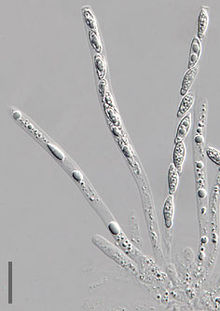Gold mold
| Gold mold | ||||||||||||
|---|---|---|---|---|---|---|---|---|---|---|---|---|

Gold mold ( Hypomyces chrysospermus ) on a boletus |
||||||||||||
| Systematics | ||||||||||||
|
||||||||||||
| Scientific name | ||||||||||||
| Hypomyces chrysospermus | ||||||||||||
| Tul. & C.Tul. (1860) |
The Gold Mold ( Hypomyces chrysospermus , English bolete eater, bolete mold ) is a species of fungus from the family of crustal ball mushroom relatives . The parasitic tubular fungus grows on tubules and gives the infected hosts a whitish, golden yellow or brownish yellow color. It occurs in Eurasia and North America as well as in southwestern Western Australia . Unlike the related Hypomyces lactifluorum , H. chrysospermus and the hosts it infects are inedible.
description
Hypomyces chrysospermus infects tubular fungi, initially with a thin whitish layer that later turns golden yellow and finally takes on a reddish-brown pustular appearance. The meat of the boletus becomes soft and decays in the third stage. Boletus can be infected with single or multiple fruiting bodies, as well as members of the genera Paxillus and Rhizopogon .
The ascospores are oval, soft in the white stage and 10–30 by 5–12 μm in size; they become warty, round and thick-walled in the yellow stage, their diameter is then 10-25 μm. Both stages are asexual while the terminal stage is sexual; here the spores are spindle-shaped and measure 25–30 by 5–6 μm.
distribution and habitat
The gold mold occurs in North America and Europe, where it is widespread. It is also common in southwestern Western Australia, where it grows in forests and coastal plant communities. It is also found in the east Chinese provinces of Hebei , Jiangsu , Anhui and Fujian .
Taxonomy
Hypomyces chrysospermus was first described in 1860 by the French mycologists Louis René and Charles Tulasne .
The species belongs to a genus of parasitic sac fungi, each of which infects different genera of other fungi. For example, attacks H. lactifluorum mushrooms from the family of Täublingsverwandten , H. completus and H. trans formans Suillus and H. melanocarpus Gallen boletes , while other species of the genus have a much broader host range.
Synonyms
The following synonyms are described:
- Hypolyssus chrysospermus (Tul. & C.Tul.) Kuntze (1898)
- Apiocrea chrysosperma (Tul. & C.Tul.) Syd. & P.Syd. (1921)
- Sepedonium chrysosperma (Bull.) Fr.
use
As mentioned above, H. chrysospermus is inedible and could also be poisonous. The mushroom is used in Chinese herbal medicine to stop external bleeding, primarily by using the spores on open wounds or cuts.
Individual evidence
- ↑ a b c d e David Arora: Mushrooms demystified: a comprehensive guide to the fleshy fungi , 2nd edition, Ten Speed Press, Berkeley 1986, ISBN 0-89815-169-4 .
- ↑ a b c Roger Phillips: Mushrooms . Pan MacMillan, 2006, ISBN 0-330-44237-6 .
- ↑ a b c Ying, Jianzhe: Icons of medicinal fungi from China . Science Press, Beijing, China 1987, ISBN 9787030001955 , p. 575.
- ^ Richard Robinson: Fungi of the South-West Forests . Department of Conservation and land Management, Perth, Western Australia 2003, ISBN 0-7307-5528-2 .
- ↑ GW Douhan, DM Rizzo: Host-parasite relationships among bolete infecting Hypomyces species . In: Mycological Research . 107, No. Pt 11, 2003, pp. 1342-1349. doi : 10.1017 / S0953756203008542 .
- ↑ Hypomyces chrysospermus Tul. & C. Tul. 1860 . In: MycoBank . International Mycological Association. Retrieved July 1, 2011.
